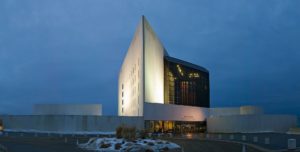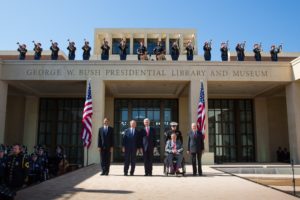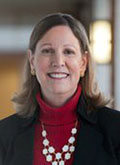Creating Presidential Libraries: Lessons from History
Written by Barbara Perry, Gerald L. Baliles Professor and Director of Presidential Studies, and Sheila M. Blackford, Librarian and Managing Editor of American President, UVA’s Miller Center. Follow them on Twitter @BarbaraPerryUVA and @Sheila_bl.
All presidents since Herbert Hoover have established libraries to house their presidential archives and museums. Barack Obama’s will be situated on Chicago’s South Side, and his presidential center will focus on civic engagement and training new generations of leaders around the world—a legacy befitting Obama’s career and historic presidency.
Like many of his predecessors, President Obama’s plans have met the inevitable obstacles that come with any major complex undertaking, but the president should take heart from the lessons of history in creating previous presidential libraries.
Lesson 1: Make sure your family is on board. Franklin Roosevelt, the first president to plan a post-presidential library, should have had the easiest road to construction. He chose his birthplace at Hyde Park, New York, even sketching the architectural design in his favorite Dutch colonial style. Yet his redoubtable mother, Sarah Delano Roosevelt, the legal owner of Hyde Park, was reluctant to deed her property to the federal government. In 1938, the president’s mother had to be tracked down on holiday in France to sign over her rights to a portion of the Hyde Park estate. She thought her adored son richly deserved a presidential library—just not adjacent to her baronial mansion. Nevertheless, the Franklin D. Roosevelt Library, which FDR dedicated in June 1941, opened just two months before her death.
Lesson 2: Don’t count on your alma mater. John Kennedy wanted his presidential library affiliated with Harvard and in May 1963 traveled to Boston to scout potential sites along the Charles River. By 1970, seven years after the president’s assassination, acquisition of a site near Harvard Yard seemed assured, but Cambridge residents, already frustrated by traffic congestion, protested. On the 10th anniversary of the president’s death, ground had yet to be broken. Two years later, the Kennedy Library Corporation abandoned the Harvard site and accepted an invitation to build a memorial to the slain president on land adjacent to the University of Massachusetts-Boston. Harvard’s rejection was perhaps a blessing in disguise, as I. M. Pei’s modern 10-story building, consisting of white poured concrete and glass, rises dramatically at the water’s edge, overlooking Boston harbor. It’s a poignant reminder of JFK’s love of the sea.

Lesson 3: Expect ideological opposition. The massive Reagan Library sits atop a picturesque mountain, with stunning views of the Pacific Ocean, in Simi Valley, California. This majestic location, however, wasn’t the president’s initial choice. In 1984, the Reagan Foundation and Stanford University reached an agreement to situate the library in Palo Alto. But the foundation also proposed a public affairs center, administered by the conservative Hoover Institute. Stanford faculty balked at that arrangement, arguing that the center might compromise the university’s academic independence by linking it to yet another conservative president, and university administrators insisted on placing the center under their control. Reagan’s foundation withdrew from the agreement and scrambled to find a new location. Developers donated 100 acres in a rural area of southern California. In November 1988, President Reagan broke ground in Simi Valley, where his library opened three years later.
George W. Bush faced a similar controversy when he chose his wife’s alma mater, Southern Methodist University, for the site of his presidential library. Some SMU faculty vociferously opposed associating the university with the 43rd president’s unpopular policies, particularly the ongoing Iraq war. Still, the library opened to celebratory fanfare in 2013.

Lesson 4: Avoid potential scandals. On President George H. W. Bush’s last day in office, Archivist of the United States Don W. Wilson signed an agreement that gave the president exclusive legal control over his administration’s computer records. Three weeks later, Wilson announced his appointment as the Bush Library’s executive director. Many critics decried the possible conflict of interest. A court case invalidated the late-night deal between Bush and Wilson, ruling that it violated the Presidential Records Act of 1978. Nevertheless, Wilson served as director of the Bush Library for five years.
Lesson 5: Make good on economic development. The Clinton Library in Little Rock models how a presidential library can infuse financial resources into an urban sector. The Little Rock Regional Chamber of Commerce estimates that the Clinton Presidential Center has generated millions of dollars in economic impact and helped revitalize the warehouse district and downtown area. Yet design work on the project faced delays while two lawsuits over land acquisition wound through the courts.
Despite familial, real estate, ideological, archival, and development disputes, every modern POTUS has eventually realized his vision of a presidential library. The Obamas simply need to remain persistent and resurrect their campaign mantra, “Yes we can!”
- Musings on National Violin Day
- Making the Promise Real: How a UN Tax Convention Can Fulfill the UNDHR’s Vision
- Having a Drink With Your Donkey: The Absurd in Antiquity
- UVA Club of Atlanta: Virtual Pilates Class
- UVA Club of Fairfield/Westchester: Cavs Care - Food Pantry Donation Drive
- UVA Club of Washington DC: December Book Club

